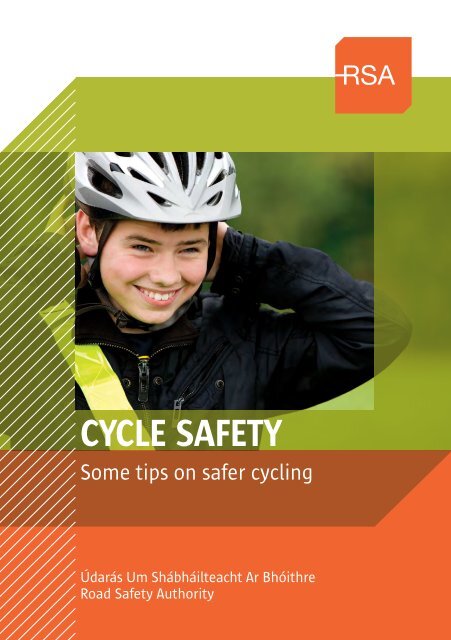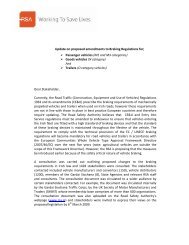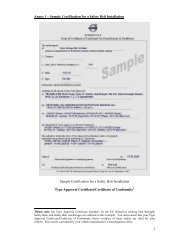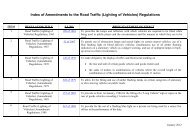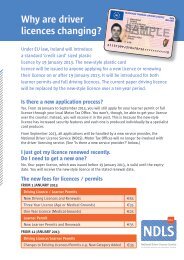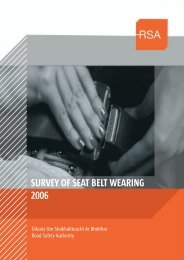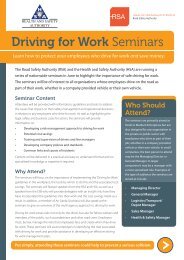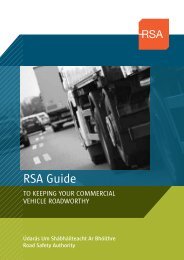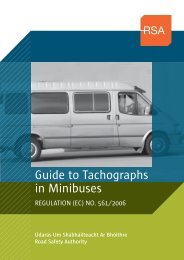Create successful ePaper yourself
Turn your PDF publications into a flip-book with our unique Google optimized e-Paper software.
<strong>Cycle</strong> <strong>Safety</strong>Some tips on safer cyclingÚdarás Um Shábháilteacht Ar BhóithreRoad <strong>Safety</strong> Authority
Be safeFor further information on safe cycling, please look at the Rules of the Road website atwww.rulesoftheroad.ie
<strong>Get</strong>ting startedCycling is enjoyable and healthy.This booklet will give you some tips on how to make it safer as well.A bicycle is not a toy!When you take your bicycle onto the road, you will be travelling with many othervehicles which are bigger and faster – and much more dangerous.Is the bicycle the right size for you?Riding a bicycle which is too big or too small is very dangerous. When on thesaddle, both your feet should touch the ground.Is the bicycle working properly?• If you are buying a new bicycle, ask the salesperson to tell you all about it.Find out how to look after your bike and keep it working properly.• If you are buying a used bicycle, get an expert to check it carefully beforeyou buy.• Whether new or used, check your bicycle regularly. If something is notworking properly do not use your bicycle until it is fixed.1
<strong>Get</strong> to knowyour bike105127691384311122
1. BellBe sure your bell works! Your handsshould be able to easily reach it.2. BrakesReplace brake blocks when theybecome worn.3. ChainKeep the chain at the correcttension, clean and well oiled.4. GearsCheck that they are workingcorrectly and adjust as required.5. HandlebarsMake sure your handlebars and gripsare properly adjusted and tight.6. LampsYour front headlight must be awhite or yellow light. Your rear taillight must be red and other roadusers should be able to see yourfront light from 150 metres andyour red tail light from 180 metres.You can use flashing lights on yourbike.7. MudguardsKeep your mudguards securelyfastened.8. PedalsLubricate (oil) your bearings andspindle of the pedal and rememberto replace worn treads.9. ReflectorsYour bicycle must be fitted witha red reflector to the rear. Wherereflectors are fitted in pedalsthey must be amber in colour.Remember you should keepreflectors on pedals clean.10. SaddleKeep your saddle properly adjustedand tight.11. SpokesKeep your spokes tight and replacebroken ones straight away.12. TyresInflate your tyres to the correctpressure which is shown on the sideof the tyre.Use a proper cycle pump andreplace worn tyres.13. WheelsYour wheels should rotatesmoothly, and you should lubricatebearings, and keep axle nuts tight.“It’s the law to have a bell on your bike at alltimes and to have working lights.”3
Be safeAlways wear a helmet when you ride your bicycleWearing a helmet reduces the risk of you getting a head injury by 69 to 85 percent 1, 2 .Ask the experts at your bicycle shop about the best helmet for you.• A helmet should have a “CE” mark and should be EN 1078 compliant toshow it meets European <strong>Safety</strong> Standards.• Pick a helmet that fits your head well before adjusting it. Then use theadjustable straps and or sizing pads to make sure it is a snug fit for you.• Pick a helmet that fits you or your child now, not a helmet to “grow into”.• Follow the manufacturer’s instructions on when to replace your helmet.A helmet is not a fashion statement. It is an essential, life-saving piece of cyclingequipment. If your helmet gets a bang in a crash, replace it even if you cannotsee the damage.Be seenWhen cycling you should always wear fluorescent and reflective clothing to makesure other road users can see you. This includes high visibility vests, armbands,and Sam Brown reflective belts.These safety accessories should all meet European <strong>Safety</strong> Standards. Adult highvisibility vests should be EN471 compliant. Children’s high visibility vests shouldbe EN1150/1999 compliant. Children’s and adult armbands and Sam Brownadjustable belts should be EN13356 compliant.The brighter, the better.1 Thompson, D.c.; Rivara, F.P. and Thompson, R.S. (1996). Effectiveness of bicycle safety helmets in preventing headinjury. A case-control study. JAMA, 276(24), 1968-1973.2 Thompson, R.; Rivara, F. and Thompson, D. (1989). A case control study of the effectiveness of bicycle safetyhelmets. New Eng J Med. 320(21), 1361-1367.4
Sharing theroad safelyTop tipsAlways be aware that cyclists are vulnerable road users.The RSA recommends that children younger than 12 should not ride bicycles inany type of traffic.• Know how to control your bike before cycling in traffic.• Never weave in and out of traffic. Stay in your lane and signal your turns.• Always cycle with the flow of traffic.• Never hold on to a moving vehicle.• Never wear an mp3 player or iPod or use a mobile phone when you are cycling.• Always obey the Rules of the Road. Other road users will respect you moreif you respect the rules.• Think ahead. Think about what drivers may do. Catch their eye.• Ride well clear of the kerb. It will help drivers to see you and will preventyour pedal hitting the kerb. You also have more room to move if you comeacross obstacles or if vehicles pass too close to you.• Show drivers what you plan to do. Always look and signal before you start,stop or turn.• Ride a straight line past parked cars rather than be constantly weaving inand out.• Ride positively and decisively. It helps motorists to understand what youplan to do.• Keep well back from motor vehicles in case they brake.• Never cycle on a footpath unless it has a cycle track. Use cycle tracks and orlanes where provided.• Never cycle side by side with more than one cyclist.5
Traffic lightsand road signs• On approach to a green light, you may proceed if its safe to do so.• Anticipate that it may change to amber.• You must stop at an amber light unless it is not safe to do so.• Never try to race through an intersection when the traffic light shows amber.• Come to a full stop when the light is red.• Do not move off until the light has turned green and it is safe to do so.• A stop sign means STOP for all vehicles – including bicycles.• Stay safe! Learn and obey all the Rules of the Road.Be particularly careful when a road sign warns of an oncominghazard – like a dangerous bend or a pedestrian crossing.Signalling• Always look back before you signal.• Always signal a turn or a change of lane clearly and in good time.• Never pull out, turn, or change lanes without signalling.Turning left• Stay in the left lane when you are turning left.• Signal your turn in good time.• Never cycle between another left turning vehicle and the kerb. Stay wellbehind it and let it go. Then turn and don’t swing out into the road.• Never pass a vehicle on the inside when it may turn left. Keep well clear ofbuses and trucks near junctions.6
“Like all road users, cyclists mustobey the Rules of the Road.”Turning right• Turning right can be very dangerous. Many collisions happen when cyclistsare turning right.• Plan your turn well in advance.• Look back. Signal. Then look back again before you move into the rightlane.• As you approach a junction, look all around and stop if required. Look rightand left and then look right again. Ensure it is safe to proceed, otherwisestop.• When it is safe to go, you should signal again and move off.• Stay well into the left as you enter the lane if you don’t feel confident.Watch out for cars, trucks and busesCars, trucks and other vehicles can be dangerous to cyclists even when they areparked.• Always signal and pull out well in advance when you are passing a parkedvehicle.• Leave plenty of space when you are passing – if someone opens a door, itcan knock you off your bicycle.• <strong>Cycle</strong> in single-file when you are overtaking parked vehicles.• Remember all vehicles have blind spots and the driver may not be able tosee you.Tram tracksCyclists need to take special care because tram tracks can be slippery, especiallyduring wet or icy weather. In particular, cyclists should avoid braking while ontram rails. They should always cross tram rails at a right angle or as close to it aspossible. They should take care to avoid getting their bicycle wheels caught in thegroove of the tram rails.7
Facilities for Cyclists<strong>Cycle</strong> tracksA cycle track is a part of a road or footway, which is provided primarily for theuse of pedal cyclists. Cyclists are advised to use these tracks wherever they areprovided however, by law a cyclist must use any cycle trackprovided as part of a pedestrian street or area or as part ofa contra-flow cycle track.There are different types of cycle tracks.l On road: (cycle lanes) are tracks provided at the samelevel as the main carriageway. A solid white line meansthat other vehicles cannot drive or park in them duringtheir hours of operation.A broken white line means that other vehicles can drive, loadand or unload and park in them for 30 minutes during theirhours of operation.l Off road (two types):• Segregated tracks are tracks separated from the roadand the foothpath by a kerb or a verge.• At footpath level tracks are tracks that are at the samelevel as the foothpath and they are sometimes onlyseparated by a white line. The line indicates the side pedestrians can walkon and the side for cyclists. Cyclists should still watch out for pedestrians,give them plenty of room and be prepared for them to change directionsuddenly.l Two-way: Some off-road cycle tracks accommodate cyclists travelling in bothdirections. Unless the design or signage indicates otherwise, cyclists shouldstay as near as possible to the left-hand side of the track. Cyclists should becareful where two-way tracks cross side roads.l Contra-flow: These tracks are found in some one-way streets and cyclists mustuse them where they are provided. This allows cyclists to travel safely againstthe main traffic flow. Don’t use these tracks to travel in the same direction astraffic as this may interfere with cyclists travelling in the opposite direction.8
<strong>Cycle</strong>waysOnly pedal cyclists or pedal cyclists and pedestrians should use a cycleway. Wherepedestrians are allowed to use certain cycleways, you should take care and givethem plenty of space when passing.Bus lanesIn general, as a cyclist, you can use the same lanes as buses,even where there is a parallel cycle track. You are not allowedto enter contra-flow bus lanes unless the signs say you can.When using bus lanes, you should be careful of buses and taxistopping along the route.Advanced Stop LinesAdvanced Stop Lines require general traffic to stop at thefirst stop line (the advanced line) but permits you to stopin front of traffic between the advanced stop line and themain stop line. The waiting area, identified by a bicyclesymbol and usually with a different surface colour, allowscyclists turning right to get into position while the lightsare red. You should be careful when doing this as thelights might change.Parking your bicyclel If your local area provides space to park bicycles, use them.l Never park your bicycle where it could cause problems especially for peoplewith disabilities or on busy footpaths.l Use a strong bicycle lock.Further information can be found in the Rules of the Road www.rulesoftheroad.ieand the National Transport Authority’s <strong>Cycle</strong> Manual www.cyclemanual.ie.<strong>Cycle</strong> to work schemeThe <strong>Cycle</strong> to Work Scheme allows employees who are paying tax in <strong>Ireland</strong> tobuy a bicycle and associated equipment tax free. Using the Bike to Work scheme,your employer can help you obtain a new bike and safety equipment worth up toE1,000. You can give a part of your salary to pay for the bike each month. By doingthis you can save almost half (47%) of the retail price of the bike and equipment.Your employer also makes savings to encourage them to get involved in thescheme. For further information, please visit www.biketowork.ie.
2013 © CopyrightRSA websiteRules of the Road website


